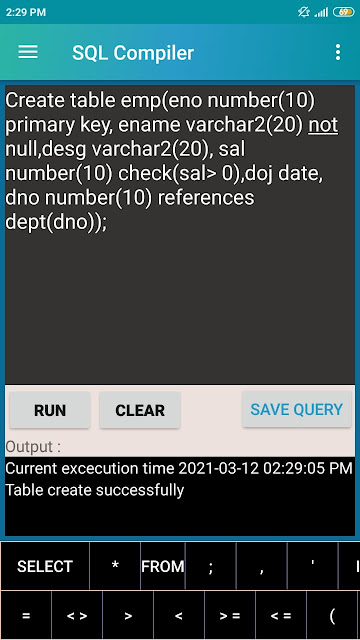SQL>Connect
Enter user name:Admin
Enter Password:
Connected
SQL>create table dept(dno number(10) primary key,dname varchar2(20), loc varchar2(20));
Table created
SQL>create table emp(eno number(10) primary key,ename varchar2(20) not null,desg varchar2(20),sal number(10) check (salary>0) ,doj date,dno number(10) references dept(dno));
Table created
SQL>insert into dept values(1,'Account','Pune');1 row created
SQL>insert into dept values(2,'Quality','Pune');
1 row created
SQL>insert into dept values(3,'computer science','pimpri');
1 row created
SQL>insert into dept values(4,'computer science','Mumbai');
1 row created
SQL>insert into dept values(5,'Quality','Mumbai');
1 row created
SQL>insert into emp values(1,'Mr. Advait','Accountant',10000,12-2-1999,2);
1 row created
SQL>insert into emp values(2,'Mr. Roy','CEO',51000,15-6-2019,2);
1 row created
SQL>insert into emp values(3,'Akshay','Manager',8000,10-6-2016,4);
1 row created
SQL>insert into emp values(4,'Ram','Designer',20000,15-5-2011,4);
1 row created
SQL>insert into emp values(5,'Ramesh','Tester',15000,25-2-2010,3);
1 row created
SQL>insert into emp values(6,'Gargi','Developer',15000,15-2-2010,1);
1 row created
Q.1 Add column phone_No into Emp table with data type int.
SQL>alter table emp add phone_no int;
Table created
SQL>update emp set phone_no=9970676878;
1 row created
Q.2 Delete the details of Employee whose designation is ‘Manager’.
SQL> delete from emp
where desg='Manager';
1 row deleted
1. Display the count of employees department wise.
SQL> select dname , count(eno)
from dept ,emp
where dept.dno=emp.dno
group by dname;
2. Display the name of employee who is ‘Manager’ of “Account Department”.
SQL> select eno,ename,desg,dname
from dept ,emp
where dept.dno=emp.dno and
desg='Manager' and desg='Account';
3.Display the name of department whose location is “Pune” and “Mr. Advait” is working in it.
SQL> select dname
from dept ,emp
where dept.dno=emp.dno and
loc='Pune' and ename='Mr. Advait';
4.Display the names of employees whose salary is greater than 50000 and department is “Quality”.
SQL> select ename
from dept ,emp
where dept.dno=emp.dno and
sal>50000 and dname='Quality';
5. Update Dateofjoining of employee to ‘15/06/2019’ whose department is ‘computer science’ and name is “Mr. Roy’.
SQL> update emp set doj='15-6-2019'
where ename='Mr. Roy' and
dno in (select dno from where
dname='computer science');



